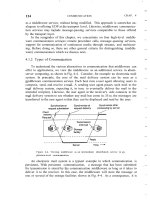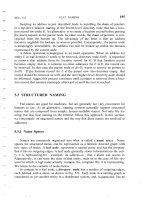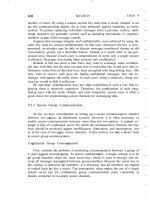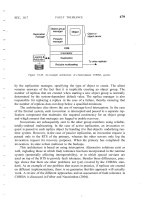DISTRIBUTED SYSTEMS principles and paradigms Second Edition phần 6 pptx
Bạn đang xem bản rút gọn của tài liệu. Xem và tải ngay bản đầy đủ của tài liệu tại đây (1.43 MB, 71 trang )
SEC. 8.3
RELIABLE CLIENT-SERVER COMMUNICATION 337
8.3.1 Point-to-Point Communication
In many distributed systems, reliable point-to-point communication is esta-
blished by making use of a reliable transport protocol, such as TCP. TCP masks
omission failures, which occur in the form of lost messages, by using ack-
nowledgments and retransmissions. Such failures are completely hidden from a
TCP client.
However, crash failures of connections are not masked. A crash failure may
occur when (for whatever reason) a TCP connection is abruptly broken so that no
more messages can be transmitted through the channel. In most cases, the client is
informed that the channel has crashed by raising an exception. The only way to
mask such failures is to let the distributed system attempt to automatically set up a
new connection, by simply resending a connection request. The underlying
assumptioriis that the other side is still, or again, responsive to such requests.
8.3.2 RPC Semantics in the Presence of Failures
Let us now take a closer look at client-server communication when using
high-level communication facilities such as Remote Procedure Calls (RPCs). The
goal of RPC is to hide communication by making remote procedure calls look just
like local ones. With a few exceptions, so far we have come fairly close. Indeed,
as long as both client and server are functioning perfectly, RPC does its job well.
The problem comes about when errors occur. It is then that the differences be-
tween local and remote calls are not always easy to mask.
To structure our discussion, let us distinguish between five different classes of
failures that can occur in RPC systems, as follows:
1. The client is unable to locate the server.
2. The request message from the client to the server is lost.
3. The server crashes after receiving a request.
4. The reply message from the server to the client is lost.
5. The client crashes after sending a request.
Each of these categories poses different problems and requires different solutions.
Client Cannot Locate the Server
To start with, it can happen that the client cannot locate a suitable server. All
servers might be down, for example. Alternatively, suppose that the client is com-
piled using a particular version of the client stub, and the binary is not used for a
considerable period of time. In the meantime, the server evolves and a new ver-
sion of the interface is installed; new stubs are generated and put into use. When
338
FAULT TOLERANCE
CHAP. 8
the client is eventuaIJy run, the binder will be unable to match it up with a server
and will report failure. While this mechanism is used to protect the client from ac-
cidentally trying to talk to a server that may not agree with it in terms of what pa-
rameters are required or what it is supposed to do, the problem remains of how
should this failure be dealt with.
One possible solution is to have the error raise an exception. In some lan-
guages, (e.g., Java), programmers can write special procedures that are invoked
upon specific errors, such as division by zero. In C, signal handlers can be used
for this purpose. In other words, we could define a new signal type
SIGNO-
SERVER, and allow it to be handled in the same way as other signals.
This approach, too, has drawbacks. To start with, not every language has
exceptions or signals. Another point is that having to write an exception or signal
handler destroys the transparency we have been trying to achieve. Suppose that
you are a programmer and your boss tells you to write the sum procedure. You
smile and tell her it will be written, tested, and documented in five minutes. Then
she mentions that you also have to write an exception handler as well, just in case
the procedure is not there today. At this point it is pretty hard to maintain the illu-
sion that remote procedures are no different from local ones, since writing an
exception handler for "Cannot locate server" would be a rather unusual request in
a single-processor system. So much for transparency.
Lost Request Messages
The second item on the list is dealing with lost request messages. This is the
easiest one to deal with: just have the operating system or client stub start a timer
when sending the request. If the timer expires before a reply or acknowledgment
comes back, the message is sent again. If the message was truly lost, the server
will not be able to tell the difference between the retransmission and the original,
and everything will work fine. Unless, of course, so many request messages are
lost that the client gives up and falsely concludes that the server is down, in which
case we are back to "Cannot locate server." If the request was not lost, the only
thing we need to do is let the server be able to detect it is dealing with a
retransmission. Unfortunately, doing so is not so simple, as we explain when dis-
cussing lost replies.
Server Crashes
The next failure on the list is a server crash. The normal sequence of events at
a server is shown in Fig. 8-7(a). A request arrives, is carried out, and a reply is
sent. Now consider Fig. 8-7(b). A request arrives and is carried out, just as be-
fore, but the server crashes before it can send the reply. Finally, look at Fig. 8-
7(c). Again a request arrives, but this time the server crashes before it can even
be carried out. And, of course, no reply is sent back.
SEC. 8.3
RELIABLE CLIENT-SERVER COMMUNICATION 339
Figure 8-7. A server in client-server communication. (a) The normal case.
(b) Crash after execution. (c) Crash before execution.
The annoying part of Fig. 8-7 is that the correct treatment differs for (b) and
(c). In (b) the system has to report failure back to the client (e.g., raise, an excep-
tion), whereas in (c) it can just retransmit the request. The problem is that the cli-
ent's operating system cannot tell which is which. All it knows is that its timer has
expired.
Three schools of thought exist on what to do here (Spector, 1982). One philo-
sophy is to wait until the server reboots (or rebind to a new server) and try the op-
eration again. The idea is to keep trying until a reply has been received, then give
it to the client. This technique is called at least once semantics and guarantees
that the RPC has been carried out at least one time, but possibly more.
The second philosophy gives up immediately and reports back failure. This
way is called at-most-once semantics and guarantees that the RPC has been car-
ried out at most one time, but possibly none at all.
The third philosophy is to guarantee nothing. When a server crashes, the cli-
ent gets no help and no promises about what happened. The RPC may have been
carried out anywhere from zero to a large number of times. The main virtue of
this scheme is that it is easy to implement.
None of these are terribly attractive. What one would like is exactly once
semantics, but in general, there is no way to arrange this. Imagine that the remote
operation consists of printing some text, and that the server sends a completion
message to the client when the text is printed. Also assume that when a client
issues a request, it receives an acknowledgment that the request has been
delivered to the server. There are two strategies the server can follow. It can either
send a completion message just before it actually tells the printer to do its work,
or after the text has been printed.
Assume that the server crashes and subsequently recovers. It announces to all
clients that it has just crashed but is now up and running again. The problem is
that the client does not know whether its request to print some text will actually be
carried out.
There are four strategies the client can follow. First, the client can decide to
never reissue a request, at the risk that the text will not be printed. Second, it can
decide to always reissue a request, but this may lead to its text being printed
twice. Third, it can decide to reissue a request only if it did not yet receive an
The parentheses indicate an event that can no longer happen because the server
already crashed. Fig. 8-8 shows all possible combinations. As can be readily veri-
fied, there is no combination of client strategy and server strategy that will work
correctly under all possible event sequences. The bottom line is that the client can
never know whether the server crashed just before or after having the text printed.
Figure 8-8. Different combinations of client and server strategies in the pres-
ence of server crashes.
acknowledgment that its print request had been delivered to the server. In that
case, the client is counting on the fact that the server crashed before the print re-
quest could be delivered. The fourth and last strategy is to reissue a request only if
it has received an acknowledgment for the print request.
With two strategies for the server, and four for the client, there are a total of
eight combinations to consider. Unfortunately, no combination is satisfactory. To
explain, note that there are three events that can happen at the server: send the
completion message (M), print the text (P), and crash (C). These events can occur
in six different orderings:
1. M ~P ~C: A crash occurs after sending the completion message
and printing the text.
2. M ~C (~P): A crash happens after sending the completion mes-
sage, but before the text could be printed.
3.
p
~M ~C: A crash occurs after sending the completion message
and printing the text.
4. P~C( ~M): The text printed, after which a crash occurs before the
completion message could be sent.
5. C (~P ~M): A crash happens before the server could do anything.
6. C(~M ~P): A crash happens before the server could do anything.
340
FAULT TOLERANCE
CHAP. 8
SEC. 8.3
RELIABLE CLIENT-SERVER COMMUNICATION
341
In short, the possibility of server crashes radically changes the nature of RPC
and clearly distinguishes single-processor systems from distributed systems. In the
former case, a server crash also implies a client crash, so recovery is neither pos-
sible nor necessary. In the latter it is both possible and necessary to take action.
Lost Reply Messages
Lost replies can also be difficult to deal with. The obvious solution is just to
rely on a timer again that has been set by the client's operating system. If no reply
is forthcoming within a reasonable period, just send the request once more. The
trouble with this solution is that the client is not really sure why there was no ans-
wer. Did the request or reply get lost, or is the server merely slow? It may make a
difference.
In particular, some operations can safely be repeated as often as necessary
with no damage being done. A request such as asking for the first 1024 bytes of a
file has no side effects and can be executed as often as necessary without any
harm being done. A request that has this property is said to be idempotent.
Now consider a request to a banking server asking to transfer a million dollars
from one account to another. If the request arrives and is carried out, but the reply
is lost, the client will not know this and will retransmit the message. The bank
server will interpret this request as a new one, and will carry it out too. Two mil-
lion dollars will be transferred. Heaven forbid that the reply is lost 10 times.
Transferring money is not idempotent.
One way of solving this problem is to try to structure all the requests in an
idempotent way. In practice, however, many requests (e.g., transferring money)
are inherently nonidempotent, so something else is needed. Another method is to
have the client assign each request a sequence number. By having the server keep
track of the most recently received sequence number from each client that is using
it, the server can tell the difference between an original request and a retransmis-
sion and can refuse to carry out any request a second time. However, the server
will still have to send a response to the client. Note that this approach does require
that the server maintains administration on each client. Furthermore, it is not clear
how long to maintain this administration. An additional safeguard is to have a bit
in the message header that is used to distinguish initial requests from retransmis-
sions (the idea being that it is always safe to perform an original request; retrans-
missions may require more care).
Client Crashes
The final item on the list of failures is the client crash. What happens if a cli-
ent sends a request to a server to do some work and crashes before the server
replies? At this point a computation is active and no parent is waiting for the re-
sult. Such an unwanted computation is called an orphan.
342
FAULT TOLERANCE
CHAP. 8
Orphans can cause a variety of problems that can interfere with normal opera-
tion of the system. As a bare minimum, they waste CPU cycles. They can also
lock files or otherwise tie up valuable resources. Finally, if the client reboots and
does the RPC again, but the reply from the orphan comes back immediately after-
ward, confusion can result.
What can be done about orphans? Nelson (1981) proposed four solutions. In
solution 1, before a client stub sends an RPC message, it makes a log entry telling
what it is about to do. The log is kept on disk or some other medium that survives
crashes. After a reboot, the log is checked and the orphan is explicitly killed off.
This solution is called orphan extermination.
The disadvantage of this scheme is the horrendous expense of writing a disk
record for every RPC. Furthermore, it may not even work, since orphans them-
selves may do RPCs, thus creating grandorphans or further descendants that are
difficult or impossible to locate. Finally, the network may be partitioned, due to a
failed gateway, making it impossible to kill them, even if they can be located. All
in all, this is not a promising approach.
In solution 2. called reincarnation, all these problems can be solved without
the need to write disk records. The way it works is to divide time up into sequen-
tially numbered epochs. When a client reboots, it broadcasts a message to all ma-
chines declaring the start of a new epoch. When such a broadcast comes in, all re-
mote computations on behalf of that client are killed. Of course, if the network is
partitioned, some orphans may survive. Fortunately, however, when they report
back, their replies will contain an obsolete epoch number, making them easy to
detect.
Solution 3 is a variant on this idea, but somewhat less draconian. It is called
gentle reincarnation. When an epoch broadcast comes in, each machine checks
to see if it has any remote computations running locally, and if so, tries its best to
locate their owners. Only if the owners cannot be located anywhere is the compu-
tation killed.
Finally, we have solution 4, expiration, in which each RPC is given a stan-
dard amount of time,
T,
to do the job. If it cannot finish, it must explicitly ask for
another quantum, which is a nuisance. On the other hand, if after a crash the client
waits a time T before rebooting, all orphans are sure to be gone. The problem to
be solved here is choosing a reasonable value of Tin the face of RPCs with wildly
differing requirements.
In practice, all of these methods are crude and undesirable. Worse yet, killing
an orphan may have unforeseen consequences. For example, suppose that an
orphan has obtained locks on one or more files or data base records. If the orphan
is suddenly killed, these locks may remain forever. Also, an orphan may have
already made entries in various remote queues to start up other processes at some
future time, so even killing the orphan may not remove all traces of it. Conceiv-
ably, it may even started again, with unforeseen consequences. Orphan elimina-
tion is discussed in more detail by Panzieri and Shrivastava (1988).
SEC. 8.4
RELIABLE GROUP COMMUNICATION 343
8.4 RELIABLE GROUP COMMUNICATION
Considering how important process resilience by replication is, it is not
surprising that reliable multicast services are important as well. Such services
guarantee that messages are delivered to all members in a process group. Unfor-
tunately, reliable multicasting turns out to be surprisingly tricky. In this section,
we take a closer look at the issues involved in reliably delivering messages to a
process group.
8.4.1 Basic Reliable-Multicasting Schemes
Although most transport layers offer reliable point-to-point channels, they
rarely offer reliable communication to a collection of processes. The best they can
offer is to let each process set up a point-to-point connection to each other process
it wants to communicate with. Obviously, such an organization is not very effi-
cient as it may waste network bandwidth. Nevertheless, if the number of proc-
esses is small, achieving reliability through multiple reliable point-to-point chan-
nels is a simple and often straightforward solution.
To go beyond this simple case, we need to define precisely what reliable mul-
ticasting is. Intuitively, it means that a message that is sent to a process group
should be delivered to each member of that group. However, what happens if dur-
ing communication a process joins the group? Should that process also receive the
message? Likewise, we should also determine what happens if a (sending) process
crashes during communication.
To cover such situations, a distinction should be made between reliable com-
munication in the presence of faulty processes, and reliable communication when
processes are assumed to operate correctly. In the first case, multicasting is con-
sidered to be reliable when it can be guaranteed that all nonfaulty group members
receive the message. The tricky part is that agreement should be reached on what
the group actually looks like before a message can be delivered, in addition to var-
ious ordering constraints. We return to these matters when we discussw atomic
multicasts below.
The situation becomes simpler if we assume agreement exists on who is a
member of the group and who is not. In particular, if we assume that processes do
not fail, and processes do not join or leave the group while communication is
going on, reliable multicasting simply means that every message should be de-
livered to each current group member. In the simplest case, there is no require-
ment that all group members receive messages in the same order, but sometimes
this feature is needed.
This weaker form of reliable multicasting is relatively easy to implement,
again subject to the condition that the number of receivers is limited. Consider
the case that a single sender wants to multicast a message to multiple receivers.
344
FAULT TOLERANCE
CHAP. 8
Assume that the underlying communication system offers only unreliable multi-
casting, meaning that a multicast message may be lost part way and delivered to
some, but not all, of the intended receivers.
Figure 8-9. A simple solution to reliable multicasting when all receivers are
known and are assumed not to fail. (a) Message transmission. (b) Reporting
feedback.
A simple solution is shown in Fig. 8-9. The sending process assigns a se-
quence number to each message it multicasts. We assume that messages are re-
ceived in the order they are sent. In this way, it is easy for a receiver to detect it is
missing a message. Each multicast message is stored locally in a history buffer at
the sender. Assuming the receivers are known to the sender, the sender simply
keeps the message in its history buffer until each receiver has returned an acknow-
ledgment. If a receiver detects it is missing a message, it may return a negative
acknowledgment, requesting the sender for a retransmission. Alternatively, the
sender may automatically retransmit the message when it has not received all ack-
nowledgments within a certain time.
There are various design trade-offs to be made. For example, to reduce the
number of messages returned to the sender, acknowledgments could possibly be
piggybacked with other messages. Also, retransmitting a message can be done
using point-to-point communication to each requesting process, or using a single
multicast message sent to all processes. A extensive and detailed survey of total-
order broadcasts can be found in Defago et al. (2004).
SEC. 8.4
RELIABLE GROUP COMMUNICATION
345
8.4.2 Scalability in Reliable Multicasting
The main problem with the reliable multicast scheme just described is that it
cannot support large numbers of receivers. If there are
N
receivers, the sender
must be prepared to accept at least
N
acknowledgments. With many receivers, the
sender may be swamped with such feedback messages, which is also referred to
as a feedback implosion. In addition, we may also need to take into account that
the receivers are spread across a wide-area network.
One solution to this problem is not to have receivers acknowledge the receipt
of a message. Instead, a receiver returns a feedback message only to inform the
sender it is missing a message. Returning only such negative acknowledgments
can be shown to generally scale better [see, for example, Towsley et al. (1997)]~
but no hard guarantees can be given that feedback implosions will never happen.
Another problem with returning only negative acknowledgments is that the
sender will, in theory, be forced to keep a message in its history buffer forever.
Because the sender can never know if a message has been correctly delivered to
all receivers, it should always be prepared for a receiver requesting the retrans-
mission of an old message. In practice, the sender will remove a message from its
history buffer after some time has elapsed to prevent the buffer from overflowing.
However, removing a message is done at the risk of a request for a retransmission
not being honored.
Several proposals for scalable reliable multicasting exist. A comparison be-
tween different schemes can be found in Levine and Garcia-Luna-Aceves (1998).
We now briefly discuss two very different approaches that are representative of
many existing solutions.
Nonhierarchical Feedback Control
The key issue to scalable solutions for reliable multicasting is to reduce the
number of feedback messages that are returned to the sender. A popular model
that has been applied to several wide-area applications is feedback suppression.
This scheme underlies the Scalable Reliable Multicasting (SRM) protocol
developed by Floyd et al. (1997) and works as follows.
First, in SRM, receivers never acknowledge the successful delivery of a mul-
ticast message, but instead, report only when they are missing a message. How
message loss is detected is left to the application. Only negative acknowledgments
are returned as feedback. Whenever a receiver notices that it missed a message, it
multicasts its feedback to the rest of the group.
Multicasting feedback allows another group member to suppress its own feed-
back. Suppose several receivers missed message
m.
Each of them will need to re-
turn a negative acknowledgment to the sender, S, so that m can be retransmitted.
However, if we assume that retransmissions are always multicast to the entire
group, it is sufficient that only a single request for retransmission reaches S.
346
FAULT TOLERANCE
CHAP. 8
For this reason, a receiver R that did not receive message
111
schedules a feed-
back message with some random delay. That is, the request for retransmission is
not sent until some random time has elapsed. If, in the meantime, another request
for retransmission for
m
reaches R, R will suppress its own feedback, knowing
that m will be retransmitted shortly. In this way, ideally, only a single feedback
message will reach S, which in turn subsequently retransmits m. This scheme is
shown in Fig. 8-10.
Figure 8·10. Several receivers have scheduled a request for retransmission, but
the first retransmission request leads to the suppression of others.
Feedback suppression has shown to scale reasonably well, and has been used
as the underlying mechanism for a number of collaborative Internet applications,
such as a shared whiteboard. However, the approach also introduces a number of
serious problems. First, ensuring that only one request for retransmission is re-
turned to the sender requires a reasonably accurate scheduling of feedback mes-
sages at each receiver. Otherwise, many receivers will still return their feedback
at the same time. Setting timers accordingly in a group of processes that is
dispersed across a wide-area network is not that easy.
Another problem is that multicasting feedback also interrupts those processes
to which the message has been successfully delivered. In other words, other re-
ceivers are forced to receive and process messages that are useless to them. The
only solution to this problem is to let receivers that have not received message
111
join a separate multicast group for
m,
as explained in Kasera et al. (1997). Unfor-
tunately, this solution requires that groups can be managed in a highly efficient
manner, which is hard to accomplish in a wide-area system. A better approach is
therefore to let receivers that tend to miss the same messages team up and share
the same multicast channel for feedback messages and retransmissions. Details on
this approach are found in Liu et al. (1998).
To enhance the scalability of SRM, it is useful to let receivers assist in local
recovery. In particular, if a receiver to which message m has been successfully
delivered, receives a request for retransmission, it can decide to multicast m even
before the retransmission request reaches the original sender. Further details can
be found in Floyd et al. (1997) and Liu et aI. (1998).
SEC. 8.4
RELIABLE GROUP COMMUNICATION
347
Hierarchical Feedback Control
Feedback suppression as just described is basically a nonhierarchical solution.
However, achieving scalability for very large groups of receivers requires that
hierarchical approaches are adopted. In essence, a hierarchical solution to reliable
multicasting works as shown in Fig. 8-11.
Figure 8-11. The essence of hierarchical reliable multicasting. Each local coor-
dinator forwards the message to its children and later handles retransmission re-
quests.
To simplify matters, assume there is only a single sender that needs to multi-
cast messages to a very large group of receivers. The group of receivers is parti-
tioned into a number of subgroups, which are subsequently organized into a tree.
The subgroup containing the sender forms the root of the tree. Within each sub-
group, any reliable multicasting scheme that works for small groups can be used.
Each subgroup appoints a local coordinator, which is responsible for handling
retransmission requests of receivers contained in its subgroup. The local coordina-
tor will thus have its own history buffer. If the coordinator itself has missed a
message
m,
it asks the coordinator of the parent subgroup to retransmit
m.
In a
scheme based on acknowledgments, a local coordinator sends an acknowledgment
to its parent if it has received the message. If a coordinator has received ack-
nowledgments for message m from all members in its subgroup, as well as from
its children, it can remove m from its history buffer.
The main problem with hierarchical solutions is the construction of the tree.
In many cases, a tree needs to be constructed dynamically. One approach is to
make use of the multicast tree in the underlying network, if there is one. In princi-
ple, the approach is then to enhance each multicast router in the network layer in
such a way that it can act as a local coordinator in the way just described. Unfor-
tunately, as a practical matter, such adaptations to existing computer networks are
348
FAULT TOLERANCE
CHAP. 8
not easy to do. For these reasons, application-level multicasting solutions as we
discussed in Chap. 4 have gained popularity.
In conclusion, building reliable multicast schemes that can scale to a large
number of receivers spread across a wide-area network, is a difficult problem. No
single best solution exists, and each solution introduces new problems.
8.4.3 Atomic Multicast
Let us now return to the situation in which we need to achieve reliable multi-
casting in the presence of process failures. In particular, what is often needed in a
distributed system is the guarantee that a message is delivered to either all proc-
esses or to none at all. In addition, it is generally also required that all messages
are delivered in the same order to all processes. This is also known as the atomic
multicast problem.
To see why atomicity is so important, consider a replicated database con-
structed as an application on top of a distributed system. The distributed system
offers reliable multicasting facilities. In particular, it allows the construction of
process groups to which messages can be reliably sent. The replicated database is
therefore constructed as a group of processes, one process for each replica. Up-
date operations are always multicast to all replicas and subsequently performed
locally. In other words, we assume that an active-replication protocol is used.
Suppose that now that a series of updates is to be performed, but that during
the execution of one of the updates, a replica crashes. Consequently, that update is
lost for that replica but on the other hand, it is correctly performed at the other
replicas.
When the replica that just crashed recovers, at best it can recover to the same
state it had before the crash; however, it may have missed several updates. At that
point, it is essential that it is brought up to date with the other replicas. Bringing
the replica into the same state as the others requires that we know exactly which
operations it missed, and in which order these operations are to be performed.
Now suppose that the underlying distributed system supported atomic multi-
casting. In that case, the update operation that was sent to all replicas just before
one of them crashed is either performed at all nonfaulty replicas, or by none at all.
In particular, with atomic multicasting, the operation can be performed by all
correctly operating replicas only if they have reached agreement on the group
membership. In other words, the update is performed if the remaining replicas
have agreed that the crashed replica no longer belongs to the group.
When the crashed replica recovers, it is now forced to join the group once
more. No update operations will be forwarded until it is registered as being a
member again. Joining the group requires that its state is brought up to date with
the rest of the group members. Consequently, atomic multicasting ensures that
nonfaulty processes maintain a consistent view of the database, and forces recon-
ciliation when a replica recovers and rejoins the group.
SEC. 8.4
RELIABLE GROUP COMMUNICA nON
349
Virtual Synchrony
Reliable multicast in the presence of process failures can be accurately de-
fined in terms of process groups and changes to group membership. As we did
earlier, we make a distinction between receiving and delivering a message. In par-
ticular, we again adopt a model in which the distributed system consists of a com-
munication layer, as shown in Fig. 8-12. Within this communication layer, mes-
sages are sent and received. A received message is locally buffered in the commu-
nication layer until it can be delivered to the application that is logically placed at
a higher layer.
Figure 8-12. The logical organization of a distributed system to distinguish between
message receipt and message delivery.
The whole idea of atomic multicasting is that a multicast message m is uniq-
uely associated with a list of processes to which it should be delivered. This
delivery list corresponds to a group view, namely, the view on the set of proc-
esses contained in the group, which the sender had at the time message m was
multicast. An important observation is that each process on that list has the same
view. In other words, they should all agree that m should be delivered to each one
of them and to no other process.
Now suppose that the message m is multicast at the time its sender has group
view G. Furthermore, assume that while the multicast is taking place, another
process joins or leaves the group. This change in group membership is naturally
announced to all processes in G. Stated somewhat differently, a view change
takes place by multicasting a message vc announcing the joining or leaving of a
process. We now have two multicast messages simultaneously in transit: m and
vc. What we need to guarantee is that m is either delivered to all processes in G
before each one of them is delivered message vc, or m is not delivered at all. Note
that this requirement is somewhat comparable to totally-ordered multicasting,
which we discussed in Chap. 6.
350
FAULT TOLERANCE
CHAP. 8
A question that quickly comes to mind is that if m is not delivered to any
process, how can we speak of a reliable multicast protocol? In principle. there is
only one case in which delivery of m is allowed to fail: when the group member-
ship change is the result of the sender of m crashing. In that case, either all mem-
bers of G should hear the abort of the new member, or none. Alternatively, m may
be ignored by each member, which corresponds to the situation that the sender
crashed before m was sent.
This stronger form of reliable multicast guarantees that a message multicast to
group view G is delivered to each nonfaulty process in G. If the sender of the
message crashes during the multicast, the message may either be delivered to all
remaining processes, or ignored by each of them. A reliable multicast with this
property is said to be virtually synchronous (Birman and Joseph, 1987).
Consider the four processes shown in Fig. 8-13. At a certain point in time,
process PI joins the group, which then consists of Ph P
2
, P
3
, and P
4
• After some
messages have been multicast, P
3
crashes. However, before crashing. it suc-
ceeded in multicasting a message to process P
2
and P
4
, but not to PI. However,
virtual synchrony guarantees that the message is not delivered at all, effectively
establishing the situation that the message was never sent before P
3
crashed.
Figure 8-13. The principle of virtual synchronous multicast.
After
P
3
has been removed from the group, communication proceeds between
the remaining group members. Later, when P
3
recovers. it can join the group
again, after its state has been brought up to date.
The principle of virtual synchrony comes from the fact that all multicasts take
place between view changes. Put somewhat differently, a view change acts as a
barrier across which no multicast can pass. In a sense. it is comparable to the use
of a synchronization variable in distributed data stores as discussed in the previous
chapter. All multicasts that are in transit while a view change takes place are com-
pleted before the view change comes into effect. The implementation of virtual
synchrony is not trivial as we will discuss in detail below.
SEC. 8.4
RELIABLE GROUP COMMUNICATION
351
~Iessage Ordering
Virtual synchrony allows an application developer to think about multicasts as
taking place in epochs that are separated by group membership changes. How-
ever, nothing has yet been said concerning the ordering of multicasts. In general,
four different orderings are distinguished:
1. Unordered multicasts
2. FIFO-ordered multicasts
3. Causally-ordered multicasts
4. Totally-ordered multicasts
A reliable, unordered multicast is a virtually synchronous multicast in
which no guarantees are given concerning the order in which received messages
are delivered by different processes. To explain, assume that reliable multicasting
is supported by a library providing a send and a receive primitive. The receive op-
eration blocks the calling process until a message is delivered to it.
Figure 8-14. Three communicating processes in the same group. The ordering
of events per process is shown along the vertical axis.
Now suppose a sender
PI
multicasts two messages to a group while two other
processes in that group are waiting for messages to arrive, as shown in Fig. 8-14.
Assuming that processes do not crash or leave the group during these multicasts, it
is possible that the communication layer at
P
2
first receives message m 1 and then
m
2.
Because there are no message-ordering constraints, the messages may be
delivered to
P
1
in the order that they are received. In contrast, the communication
layer at
P3
may first receive message m2 followed by m
I,
and delivers these two
in this same order to
P
3
•
In the case of reliable FIFO-ordered multicasts. the communication layer is
forced to deliver incoming messages from the same process in the same order as
they have been sent. Consider the ·communication within a group of four proc-
esses, as shown in Fig. 8-15. With FIFO ordering, the only thing that matters is
that message
m
1
is always delivered before
m-;
and. likewise, that message
m3
is
always delivered before m
s,
This rule has to be obeyed by all processes in the
group. In other words, when the communication layer at
P3
receives
m2
first, it
will wait with delivery to
P
3
until it has received and delivered
mI'
352
FAULT TOLERANCE
CHAP. 8
Figure 8-15. Four processes in the same group with two different senders, and a
possible delivery order of messages under FIFO-ordered multicasting.
However, there is no constraint regarding the delivery of messages sent by
different processes. In other words, if process
P2
receives m
1
before
1113,
it may
deliver the two messages in that order. Meanwhile, process P
3
may have received
m
3
before receiving mI' FIFO ordering states that P
3
may deliver m
3
before m
h
although this delivery order is different from that of
P
2
.
Finally, reliable causally-ordered multicast delivers messages so that poten-
tial causality between different messages is preserved. In other words. if a mes-
sage m
1
causally precedes another message m2, regardless of whether they were
multicast by the same sender, then the communication layer at each receiver will
always deliver m
2
after it has received and delivered m
l'
Note that causally-
ordered multicasts can be implemented using vector timestamps as discussed in
Chap. 6.
Besides these three orderings, there may be the additional constraint that mes-
sage delivery is to be totally ordered as well. Total-ordered delivery means that
regardless of whether message delivery is unordered, FIFO ordered, or causally
ordered, it is required additionally that when messages are delivered, they are de-
livered in the same order to all group members.
For example, with the combination of FIFO and totally-ordered multicast,
processes P
2
and P
3
in Fig. 8-15 may both first deliver message
m-;
and then mes-
sage mI.' However, if P
2
delivers ml before m3, while P
3
delivers m-; before
delivering m
1,
they would violate the total-ordering constraint. Note that FIFO
ordering should still be respected. In other words, m
2
should be delivered after
m
1
and, accordingly, m
4
should be delivered after m
3. .
Virtually synchronous reliable multicasting offering totally-ordered delivery
of messages is called atomic multicasting. With the three different message ord-
ering constraints discussed above, this leads to six forms of reliable multicasting
as shown in Fig. 8-16 (Hadzilacos and Toueg, 1993).
Implementing Virtual Synchrony
Let us now consider a possible implementation of a virtually synchronous
reliable multicast. An example of such an implementation appears in Isis, a fault-
tolerant distributed system that has been in practical use in industry for several
SEC. 8.4 RELIABLE GROUP COMMUNICA nON
353
Figure 8-16. Six different versions of virtually synchronous reliable multicasting.
years. We will focus on some of the implementation issues of this technique as
described in Birman et al. (1991).
Reliable multicasting in Isis makes use of available reliable point-to-point
communication facilities of the underlying network, in particular, TCP. Multicast-
ing a message m to a group of processes is implemented by reliably sending m to
each group member. As a consequence, although each transmission is guaranteed
to succeed, there are no guarantees that all group members receive m. In particu-
lar, the sender may fail before having transmitted m to each member.
Besides reliable point-to-point communication, Isis also assumes that mes-
sages from the same source are received by a communication layer in the order
they were sent by that source. In practice, this requirement is solved by using TCP
connections for point-to-point communication.
The main problem that needs to be solved is to guarantee that all messages
sent to view G are delivered to all nonfaulty processes in G before the next group
membership change takes place. The first issue that needs to be taken care of is
making sure that each process in G has received all messages that were sent to G.
Note that because the sender of a message m to G may have failed before com-
pleting its multicast, there may indeed be processes in G that will never receive m.
Because the sender has crashed, these processes should get m from somewhere
else. How a process detects it is missing a message is explained next.
The solution to this problem is to let every process in G keep m until it knows
for sure that all members in G have received it. If m has been received by all
members in G, m is said to be stable. Only stable messages are allowed to be
delivered. To ensure stability, it is sufficient to select an arbitrary (operational)
process in G and request it to send m to all other processes.
To be more specific, assume the current view is G
j,
but that it is necessary to
install the next view
G;+l.
Without loss of generality, we may assume that G; and
G
j
+
1
differ by at most one process. A process
P
notices the view change when it
receives a view-change message. Such a message may come from the process
wanting to join or leave the group, or from a process that had detected the failure
of a process in G; that is now to be removed, as shown in Fig. 8-17(a).
354
FAULT TOLERANCE
CHAP. 8
When a process P receives the view-change message for Gi+
1,
it first for-
wards a copy of any unstable message from G, it still has to every process in G
i
+
1
,
and subsequently marks it as being stable. Recall that Isis assumes point-to-point
communication is reliable, so that forwarded messages are never lost. Such for-
warding guarantees that all messages in G, that have been received by at least one
process are received by all nonfaulty processes in G
i
.
Note that it would also have
been sufficient to elect a single coordinator to forward unstable messages.
Figure 8-17. (a) Process 4 notices that process 7 has crashed and sends a view
change. (b) Process 6 sends out all its unstable messages, followed by a flush
message. (c) Process 6 installs the new view when it has received a flush mes-
sage from everyone else.
To indicate that
P
no longer has any unstable messages and that it is prepared
to install G
i
+
1
as soon as the other processes can do that as well, it multicasts a
flush message for G
i
+
b
as shown in Fig. 8-17(b). After P has received a flush
message for G
i
+
1
from each other process, it can safely install the new view
'[shown in Fig. 8-17(c)].
When. a process Q receives a message m that was sent in
G
i,
and Q still be-
'lieves the current view is G;, it delivers. m taking any additional message-ordering
'constraints into account. If it had already received
171,
'it
considers the message to
'be a duplicate and further discards it. .
Because process
Q
will eventually receive the view-change message for G
i
+
1
,
lit
will also first forward any of its unstable messages and subsequently wrap
Lpnngs up by sending a flush message.for
Gi+l,.,
Note
that due. to the message ord-
f¢ring underlying the communication layer, a flushmessage from a process is al-
\vays; received after the receipt of au unstable message from that same process. .
. 'the major flaw in the protocol described
so
Ifar
is that it cannot deal with
'process failures while a new view change is being announced. In particular, it
'assumes that until the new view G
i
+
1
has been installed by each member in G
i
+
1
,
'no-process in G
i
+
1
will fail (which would lead to a next view Gi+2)' This problem
SEC. 8.4
RELIABLE GROUP COMMUNICATION
355
is solved by announcing view changes for any view
G
i
+
k
even while previous
changes have not yet been installed by all processes. The details are left as an
exercise for the reader.
8.5 DISTRIBUTED COMMIT
The atomic multicasting problem discussed in the previous section is an ex-
ample of a more general problem, known as distributed commit. The distributed
commit problem involves having an operation being performed by each member
of a process group, or none at all. In the case of reliable multicasting, the opera-
tion is the delivery of a message. With distributed transactions, the operation may
be the commit of a transaction at a single site that takes part in the transaction.
Other examples of distributed commit, and how it can be solved are discussed in
Tanisch (2000).
Distributed commit is often established by means of a coordinator. In a simple
scheme, this coordinator tells all other processes that are also involved, called par-
ticipants, whether or not to (locally) perform the operation in question. This
scheme is referred to as a one-phase commit protocol. It has the obvious draw-
back that if one of the participants cannot actually perform the operation, there is
no way to tell the coordinator. For example, in the case of distributed transactions,
a local commit may not be possible because this would violate concurrency con-
trol constraints.
In practice, more sophisticated schemes are needed, the most common one
being the two-phase commit protocol, which is discussed in detail below. The
main drawback of this protocol is that it cannot efficiently handle the failure of
the coordinator. To that end, a three-phase protocol has been developed, which we
also discuss.
8.5.1 Two-Phase Commit
The original two-phase commit protocol (2PC) is due to Gray (1978)
Without loss of generality, consider a distributed transaction involving the partici-
pation of a number of processes each running on a different machine. Assuming
that no failures occur, the protocol consists of the following two phases, each con-
sisting of two steps [see also Bernstein et al. (1987)]:
1. The coordinator sends a VOTE REQUEST message to all partici-
pants.
2. When a participant receives a VOTE REQUEST message, it returns
either a VOTE_COMMIT message to the coordinator telling the coor-
dinator that it is prepared to locally commit its part of the transaction,
or otherwise a VOTE-ABORT message.
356
FAULT TOLERANCE
CHAP. 8·
Figure 8~18. (a) The finite state machine for the coordinator in ;2PC. (b) The
finite state machine for a participant.
Several problems arise when this basic 2PC protocol is used in a system
where failures occur. First, note that the coordinator as well as the participants
have states in which they block waiting for incoming messages. Consequently, the
protocol can easily fail when a process crashes for other processes may be inde-
finitely waiting for a message from that process. For this reason, timeout mechan-
ism are used. These mechanisms are explained in the following pages.
When taking a look at the finite state machines in Fig. 8-18, it can be seen that
there are a total of three states in which either a coordinator or participant is
blocked waiting for an incoming message. First, a participant may be waiting in
its INIT state for a VOTE-REQUEST message from the coordinator. If that mes-
sage is not received after some time, the participant will simply decide to locally
abort the transaction, and thus send a VOTE ABORT message to the coordinator.
Likewise, the coordinator can be blocked in state
"~4IT,
waiting for the votes
•
of each participant. If not all votes have been collected after a certain period of
3. The coordinator collects all votes from the participants. If all partici-
pants have voted to commit the transaction, then so will the coordi-
nator. In that case, it sends a GLOBAL_COMMIT message to all par-
ticipants. However, if one participant had voted to abort the tran-
saction, the coordinator will also decide to abort the transaction and
multicasts a GLOBAL ABORT message.
4. Each participant that voted for a commit waits for the final reaction
by the coordinator. If a participant receives a GLOBAL_COMMIT
message, it locally commits the transaction. Otherwise, when receiv-
ing a GLOBAL ABORT message, the transaction is locally aborted
as well.
The first phase is the voting phase, and consists of steps 1 and 2. The second
phase is the decision phase, and consists of steps 3 and 4. These four steps are
shown as finite state diagrams in Fig. 8-18.
SEC. 8.5
DISTRIBUTED COMMIT
357
time, the coordinator should vote for an abort as well, and subsequently send
GLOBAL ABORT to all participants.
Finally, a participant can be blocked in state READY, waiting for the global
vote as sent by the coordinator. If that message is not received within a given
time, the participant cannot simply decide to abort the transaction. Instead, it must
find out which message the coordinator actually sent. The simplest solution to this
problem is to let each participant block until the coordinator recovers again.
A better solution is to let a participant
P
contact another participant Q to see if
it can decide from Q's current state what it should do. For example, suppose that
Q
had reached state COMMIT. This is possible only if the coordinator had sent a
GLOBAL_COMMIT message to Q just before crashing. Apparently; this message
had not yet been sent to P. Consequently, P may now also decide to locally com-
mit. Likewise, if Q is in state ABORT, P can safely abort as well.
Now suppose that Q is still in state INIT. This situation can occur when the
coordinator has sent a VOTE REQUEST to all participants, but this message has
reached P (which subsequently responded with a VOTE_COMMIT message), but
has not reached Q. In other words, the coordinator had crashed while multicasting
VOTE REQUEST. In this case, it is safe to abort the transaction: both P and Q
can make a transition to state ABORT.
The most difficult situation occurs when Q is also in state READY, waiting for
a response from the coordinator. In particular, if it turns out that all participants
are in state READY, no decision can be taken. The problem is that although all
participants are willing to commit, they still need the coordinator's vote to reach
the final decision. Consequently, the protocol blocks until the coordinator recov-
ers.
The various options are summarized in Fig. 8-19.
Figure 8-19. Actions taken by a participant
P
when residing in state
READY
and having contacted another participant
Q.
To ensure that a process can actually recover, it is necessary that it saves its
state to persistent storage. (How saving data can be done in a fault-tolerant way is
discussed later in this chapter.) For example, if a participant was in state INIT, it
can safely decide to locally abort the transaction when it recovers, and then
inform the coordinator. Likewise, when it had already taken a decision such as
358
FAULT TOLERANCE
CHAP: 8
Figure 8-20. Outline of the steps taken by the coordinator in a two-phase com-
mit protocol.
If not all votes have been collected but no more votes are received within a
given time interval prescribed in advance, the coordinator assumes that one or
more participants have failed. Consequently, it should abort the transaction and
multicasts a GLOBAL-ABORT to the (remaining) participants.
when it crashed while being in either state COMMIT or ABORT, it is in order to
recover to that state again, and retransmit its decision to the coordinator.
Problems arise when a participant crashed while residing in state READY. In
that case. when recovering, it cannot decide on its own what it should do next,
that is, commit or abort the transaction. Consequently, it is forced to contact other
participants to find what it should do, analogous to the situation when it times out
while residing in state READY as described above. '
The coordinator has only two critical states it needs to keep track of. When it
starts the 2PC protocol, it should record that it is entering state WAIT so that it can
possibly retransmit the VOTEJ?EQUEST message to all participants after recov-
ering. Likewise, if it had come to a decision in the second phase, it is sufficient if
that decision has been recorded so that it can be retransmitted when recovering.
An outline of the actions that are executed by the coordinator is given in
Fig. 8-20. The coordinator starts by multicasting a VOTEJ?EQUEST to all parti-
cipants in order to collect their votes. It subsequently records that it is entering the
WAIT state, after which it waits for incoming votes from participants.
SEC. 8.5
DISTRIBUTED COMMIT
359
If no failures occur, the coordinator will eventually have collected all votes. If
all participants as well as the coordinator vote to commit, GLOBAL_COMMIT is
first logged and subsequently sent to all processes. Otherwise, the coordinator
multicasts a GLOBAL-ABORT (after recording it in the local log).
Fig. 8-21(a) showsthe steps taken by a participant. First, the process waits for
a vote request from the coordinator. Note that this waiting can be done by a sepa-
rate thread running in the process's address space. If no message comes in, the
transaction is simply aborted. Apparently, the coordinator had failed.
After receiving a vote request, the participant may decide to vote for commit-
ting the transaction for which it first records its decision in a local log, and then
informs the coordinator by sending a VOTE_COMMIT message. The participant
must then wait for the global decision. Assuming this decision (which again
should come from the coordinator) comes in on time, it is simply written to the
local log, after which it can be carried out.
However, if the participant times out while waiting for the coordinator's deci-
sion to come in, it executes a termination protocol by first multicasting a
DECISION-REQUEST message to the other processes, after which it subse-
quently blocks while waiting for a response. When a response comes in (possibly
from the coordinator, which is assumed to eventually recover), the participant
writes the decision to its local log and handles it accordingly.
Each participant should be prepared to accept requests for a global decision
from other participants. To that end, assume each participant starts a separate
thread, executing concurrently with the main thread of the participant as shown in
Fig.8-21(b). This thread blocks until it receives a decision request. It can only be
of help to anther process if its associated participant has already reached a final
decision. In other words, if GLOBAL_COMMIT or GLOBAL-ABORT had been
written to the local log, it is certain that the coordinator had at least sent its deci-
sion to this process. In addition, the thread may also decide to send a
GLOBAL-ABORT when its associated participant is still in state INIT, as dis-
cussed previously. In all other cases, the receiving thread cannot help, and the re-
questing participant will not be responded to.
What is seen is that it may be possible that a participant will need to block
until the coordinator recovers. This situation occurs when all participants have re-
ceived and processed the VOTE-REQUEST from the coordinator, while in the
meantime, the coordinator crashed. In that case, participants cannot cooperatively
decide on the final action to take. For this reason, 2PC is also referred to as a
blocking commit protocol.
There are several solutions to avoid blocking. One solution, described by
Babaoglu and Toueg (1993), is to use a multicast primitive by which a receiver
immediately multicasts a received message to all other processes. It can be shown
that this approach allows a participant to reach a final decision, even if the coordi-
nator has not yet recovered. Another solution is the three-phase commit protocol,
which is the last topic of this section and is discussed next.
360
FAULT TOLERANCE
CHAP. 8
Figure 8-21. (a) The steps taken by a participant process in 2PC. (b) The steps
for handling incoming decision requests.
SEC. 8.5
DISTRIBUTED COMMIT 361
8.5.2 Three-Phase Commit
A problem with the two-phase commit protocol is that when the coordinator
has crashed, participants may not be able to reach a final decision. Consequently,
participants may need to remain blocked until the coordinator recovers. Skeen
(1981) developed a variant of 2PC, called the three-phase commit protocol
(3PC), that avoids blocking processes in the presence of fail-stop crashes. Al-
though 3PC is widely referred to in the literature, it is not applied often in practice
as the conditions under which 2PC blocks rarely occur. We discuss the protocol,
as it provides further insight into solving fault-tolerance problems in distributed
systems.
Like 2PC, 3PC is also formulated in terms of a coordinator and a number of
participants. Their respective finite state machines are shown in Fig. 8-22. The
essence of the protocol is that the states of the coordinator and each participant
satisfy the following two conditions:
1. There is no single state from which it is possible to make a transition
directly to either a COMMIT or an ABORT state.
2. There is no state in which it is not possible to make a final decision,
and from which a transition to a COMMIT state can be made.
It can be shown that these two conditions are necessary and sufficient for a com-
mit protocol to be nonblocking (Skeen and Stonebraker, 1983).
Figure 8-22. (a) The finite state machine for the coordinator in 3PC.
(b)
The
finite state machine for a participant.
The coordinator in 3PC starts with sending a
VOTE REQUEST
message to all
participants, after which it waits for incoming responses. If any participant votes
to abort the transaction, the final decision will be to abort as well, so the coordina-
tor sends GLOBAL-ABORT. However, when the transaction can be committed, a









